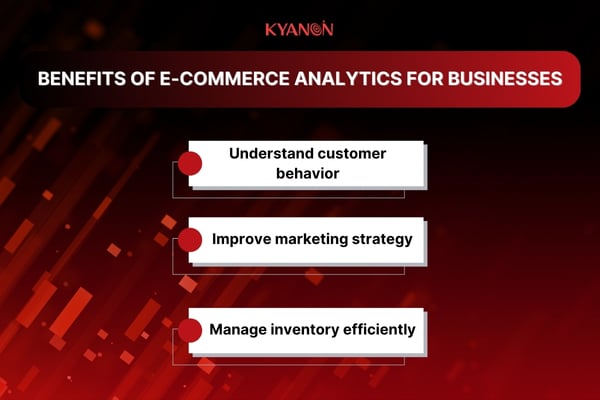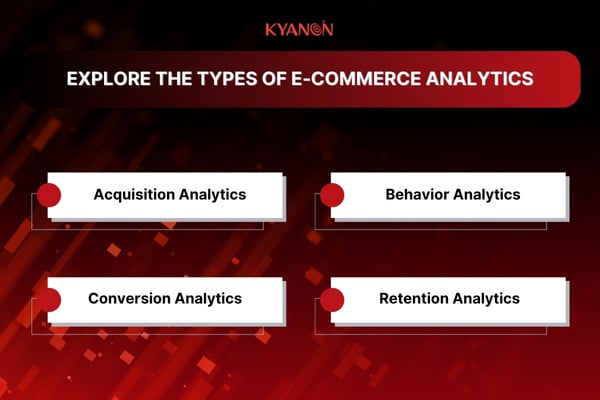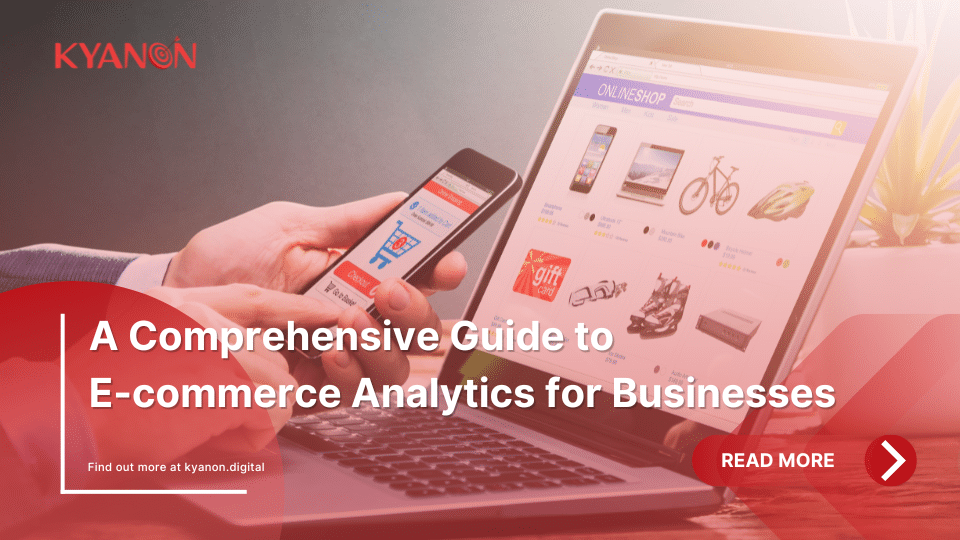In today’s rapidly expanding e-commerce landscape, simply having an online store is no longer sufficient to ensure maximum profits. The line between success and failure lies in understanding customer behavior and optimizing every aspect of your business. It’s time for businesses to adopt E-commerce Analytics to enhance user experience, maximize profits, and maintain a competitive edge in the market.
Let’s explore the comprehensive guide to E-commerce Analytics for businesses with Kyanon Digital in this blog.
1. What is E-commerce Analytics?
E-commerce Analytics is the process of collecting, measuring, and analyzing data about the activities that take place in an online store. This data can include traffic, conversion rates, customer behavior, the effectiveness of marketing campaigns, website performance, and more. By analyzing this data, businesses can identify the strengths and weaknesses of their business strategy. This will serve as a basis for businesses in making strategic decisions, improving revenue, and achieving their goals.
2. The Nature of E-commerce Analytics
Gartner predicts that 65% of B2B businesses will make decisions based on data by 2026. This once again proves that E-commerce Analytics plays a crucial role in the development of any business.
E-commerce Analytics is a tool for monitoring metrics and the key for businesses to understand every aspect of their online business, from the first click to the final checkout step. This data-driven approach helps improve user experience, increase conversion rates, and even increase revenue by 10-15% (according to a McKinsey report).
The real power of E-commerce Analytics lies in its ability to turn raw data into actionable information, transforming a simple online transaction into a long-term customer relationship. In the long run, E-commerce Analytics will continue to be a tool that helps businesses grow in a competitive and constantly changing market.
Transform your ideas into reality with our services. Get started today!
Our team will contact you within 24 hours.
3. Benefits of E-commerce Analytics for Businesses
3.1. Understand customer behavior
- Identify customer preferences: Understand which products and services customers are most interested in.
- Track the customer journey: Analyze how customers interact with the website and make purchase decisions.
- Customize the shopping experience: Customize marketing campaigns and products to suit the needs of each customer.
3.2. Improve marketing strategy
- Measure campaign effectiveness: Identify which marketing channels and campaigns generate the highest sales.
- Optimize advertising spending: Allocate marketing budgets to the most effective channels.
- Retarget customers: Reconnect with customers who have shown interest in products but have yet to purchase.
3.3. Manage inventory efficiently
- Forecast demand: Forecast future sales to adjust inventory levels accordingly.
- Avoid stockouts: Ensure there is always enough stock to meet customer demand.
- Reduce excess inventory: Minimize storage costs and dead stock.

4. Types of E-commerce Analytics
Depending on the purpose, E-commerce Analytics can be divided into different types. Data points can be divided into four main categories.
4.1. Acquisition Analytics
- Goal: This data type analyzes where customers come from and which channels provide the most value. This allows businesses to allocate budgets effectively and optimize marketing campaigns.
- Key metrics: Traffic sources (organic search, paid search, social media, email, direct, referral), customer acquisition cost, conversion rate from each channel, and number of new customers.
4.2. Behavior Analytics
- Goal: This data helps businesses understand customer interactions with their website or app, which can improve user experience and boost conversion rates.
- Key metrics: Time spent on the page, bounce rate, click-through rate (CTR), and most viewed products.

4.3. Conversion Analytics
- Goal: This data type allows businesses to track and improve the factors influencing customers’ purchasing decisions, turning website visitors into actual customers.
- Key metrics: Conversion rate, average order value, cart abandonment rate, order completion time.
4.4. Retention Analytics
- Goal: Through this data, businesses can assess and improve their ability to retain and turn existing customers into loyal customers.
- Key metrics: Customer return rate, customer lifetime value, purchase frequency, customer churn rate.
5. Tips for Effective Use of E-commerce Analytics
5.1. Set clear goals
Businesses must define specific and measurable goals, such as increasing conversion rates, improving customer retention rates, or increasing average order value. Clear goals help businesses focus on the right metrics.
5.2. Monitor key metrics
After identifying goals, businesses should focus on a few key metrics, such as conversion, traffic, bounce, and cart abandonment rates. Regular monitoring will help businesses adjust their business plans effectively.
5.3. Organize data
Instead of looking at overall data, businesses should classify data into groups such as new customers and returning customers, geographic regions, or purchase history. This will help businesses tailor their strategies to different customer groups and create personalized marketing campaigns.
6. Common Challenges in Applying E-commerce Analytics
6.1. Data volume and complexity
As online customer activity grows, the volume of data businesses must manage is also increasing rapidly. With such a huge amount of data, businesses will face difficulties in many stages:
- To store data, businesses must invest in powerful storage systems, which are often costly.
- In addition, businesses also face difficulties in analyzing complex types of data, especially unstructured data (customer reviews, social media mentions, and website click data).
6.2. Data quality
Inaccurate or incomplete data can be caused by input errors, lack of synchronization between systems, or technical issues. When data quality is low, businesses lose confidence in the data, leading to wrong decisions, wasted resources, and a degraded customer experience.

6.3. Privacy Concerns
Stricter regulations like GDPR and CCPA pose challenges for businesses in collecting, storing, and using customer data responsibly and in compliance with legal regulations, requiring businesses to have strict data control processes and advanced security.
6.4. Lack of specialized personnel
Data analysis requires a range of specific skills, including statistical skills, knowledge of data analysis tools (such as Google Analytics or SQL), and the ability to interpret data to make strategic decisions. However, many businesses do not have enough qualified personnel to do these things.
In a world where online shopping has become commonplace, adapting and analyzing data is crucial for any business. Understanding customer behavior, measuring the effectiveness of campaigns, and optimizing business processes all depend on data analysis. Businesses should use E-commerce Analytics and continuously improve, update, and optimize this tool to ensure long-term growth for their business operations.
Contact Kyanon Digital if your business needs a reliable partner to consult and implement E-commerce Analytics strategies. With experience and expertise in this field, Kyanon Digital will help you better understand data analysis to make more accurate business decisions.

















